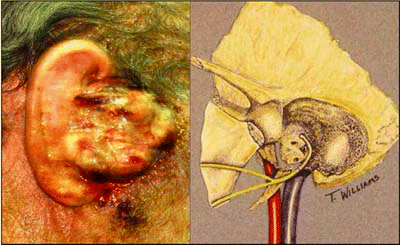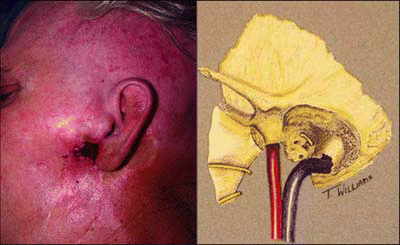Treatment
The terminology of surgery can be confusing, Dr. Hirsch continued. A sleeve resection refers to a procedure that removes the skin of the ear canal. For tumors limited to the external auditory canal, a lateral temporal bone resection is commonly performed. Following a complete mastoidectomy that is extended well into the zygomatic root, an en bloc resection of the bony external auditory canal and skin is done. This also entails removal of the tympanic membrane, malleus, and incus.
Explore This Issue
June 2007Treatment of tumors that invade the temporal bone is relatively straightforward but at the same time complex, Dr. Gidley continued. Tumors of the skin of the outer ear are typically squamous cell or advanced basal cell. These are treated with wide local excision, including temporal bone resection with parotidectomy and possibly lymph node dissection in the neck. Parotid tumors are also treated with lateral temporal bone resection and usually a total parotidectomy, attempting to preserve the facial nerve. Dr. Gidley said that parotid tumors often involve the facial nerve and a nerve graft may be necessary.
Also, these tumors are treated with selective neck dissection of the lymph nodes, depending on the pathology of the tumor and extent of invasion.
“Usually surgery for parotid tumors leaves a deficit in the facial nerve,” Dr. Gidley said.
Treatment of primary temporal bone tumors in the ear canal becomes more controversial as the tumors get larger, Dr. Gidley commented. Those that are confined to the ear canal are treated with lateral temporal bone resection, parotidectomy, and selective neck dissection. Tumors that invade the middle ear and mastoid bone are treated with a subtotal temporal bone resection combined with parotidectomy and selective neck dissection.
A total temporal bone resection involves removal of the carotid artery and is reserved for stage IV tumors, Dr. Hirsch said. A subtotal lateral temporal bone resection spares the carotid artery.
“If the tumor has eroded through the dura into the brain, surgery is contraindicated. Surgery under these conditions is not curative. Patients with severe pain should be managed with pain medications, chemotherapy, and radiotherapy,” Dr. Hirsch commented.
Dr. Hirsch said that removal of lymph nodes in the neck is controversial, because it is unclear whether a neck dissection improves survival. “In a patient with no clinical evidence of node involvement—that is, you can’t feel them and there is no suspicion on imaging—it is controversial whether to take the nodes out from the parotid gland and neck. If tumor is present, it will help determine the field of radiotherapy. Many surgeons perform a superficial parotidectomy, leaving it attached to the resected ear canal, which removes the first region of lymph node mestastases,” Dr. Hirsch said.


Leave a Reply